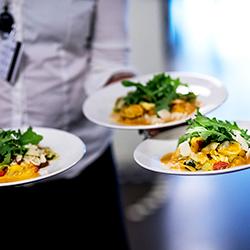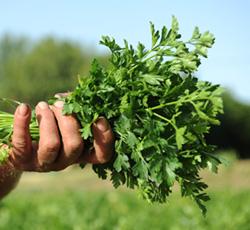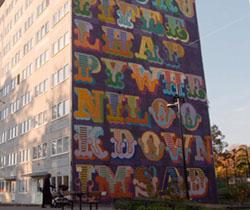Food security is a vulnerable dimension of urban resilience and sustainability. At the same time, food security issues may form a basis for the re-establishment of links between urban and rural regions. However. this is often missing in the resilience and sustainability discourse. Last week, I had the opportunity to give a talk called ‘Peri-Urban Food Production Promoting Urban Resilience and Bridging Urban and Rural Regions’ at an international conference on urban sustainability and resilience. The urban food security issues were highlighted as part of urban resilience and the potential, so far largely untapped, of the peri-urban agricultural areas for urban food provisioning. There is also a potential of social resilience by involving food processing and food production activities in promoting integration and social cohesion processes.
The urban food security issue involves dealing with the current dependence on the function and reliable deliveries of the global food system for food provisioning since approx. 60% of consumed food are imported along the global food chain. Further, emergency storage of food is absent in Sweden since 1995. Urban resilience discussions and preparedness for disturbances cannot continue to omit this aspect – as if food will be taken for granted. We need not – and cannot - aim for self-suffiency of food products, but it is a matter of decreasing the vulnerability of cities, also Gothenburg, in terms of reducing the dependence of the global food chain. The food provisioning issue for urban regions must be seriously handled and in doing so the ‘urban issues’ need to include the urban-rural regions. In this aspect the Gothenburg region has a very favourable situation with its 13 municipalities with extant agricultural land and the wider context of Västra Götalandsregion.
The linking of urban–rural regions would increase food security in the urban regions by offering alternatives to products from the global food chains and a less disturbance-sensitive food production via shorter food supply chains. Can the mutual dependence between urban and rural areas create synergies and contribute to the shaping of new landscapes with closer links between the urban and rural landscapes? The ongoing work on a local food strategy for Gothenburg by the city government, active support from local city government to a number of new economic collaboration forms on food production involving community organisations, individuals, and active interests from some peri-urban municipalities, give great potential and perspectives for the relevant attention of one of the most important dimensions of urban resilience.
The conference was held at University College of London last week, in June 2017. The conference gathered a large group of researchers within the urban field and thus by nature interdisciplinary. The themes for the conference: Achieving both sustainable and resilient cities; Resilient infrastructure; Green infrastructure; Urban recovery post-disaster; The circular economy; were presented in 15 parallel sessions.
The mainpart of current research and organisation activities on Resilient cities presented in the conference circled around infrastructure & transport & communication, preparedness for catastrophic events and hazards like flooding, energy breaks and sabotage etc, renewable energy sources, design of housings, planning and adaptation activities for climate change. Those are all very important and challenging and a number of unsolved, often context dependent questions, are remaining.
A thought-provoking contribution was on the spatial dimension of circular economy. Here the ambition is to plan and design urban region’s metabolism and industrial processes to reuse material and old infrastructures, align to previous historical land and resource use - highly context dependant – and providing pathways towards transitions to sustainable urban-rural regions. Ambitious efforts on assessments and estimations of cities’ environmental footprints were presented. However, it was not clear how the footprints of consumption, including food, would be calculated although this is one of the most urgent issues to handle related to urban resilience.
I also had the opportunity to chair a session on Green infrastructure, where a project on benchmarking on urban and peri-urban green infrastructure using criteria on Water management, Nature conservation and Human health and wellbeing was presented. The multidimensionality of ‘green spaces’ and their capacity to deliver a number of ecosystem services was highlighted. Such services include climate change resilience, net biodiversity gain through habitat creation and flourishing communities through provision of accessible, natural green space for play, recreation, education, food production, and spaces for public events. The London air here in Bloomsbury is filled of the characteristic sweet scent of flowering lime trees, realising that there are numerous trees and small green spaces among the old buildings. In the Wednesday morning the first sight on the news is the big skyskcraper engulfed in flames, the devastating fire in a building block for refugees and jobless people – another part of London away from the services in central London…
GUNILLA ALMERED OLSSON – is professor in Human Ecology at School of Global Studies at University of Gothenburg, Sweden. Her work is characterized by an interdisciplinary perspective on use and management of natural resources, biodiversity and ecological limits in numerous collaborative research projects connecting environmental and social sciences, in Scandinavia, Europe and Africa. She has also been working on management of natural resources for Swedish government (Ministry of Environment) and in United Nations Environment Program. Current research is on food security and urban resilience and links to peri-urban and rural regions within the context of sustainable development. She is a co-author to global research surveys for Intergovernmental Panel for Biodiversity and Ecosystem Services (IPBES) with specific focus on pathways towards sustainable futures.
In the aspiration to support the ongoing food activities in Gothenburg and their relevance for urban resilience a network on Urban Food was formed in 2016, the Mistra Urban Futures’ Network Urban Food. See the conference program and a short presentation of the MUF Network Urban Food page at Mistra Urban Futures’ website.
.
Peri-urban agriculture, Hisingen, Gothenburg municipality. Photo. G.A. Olsson 2014. Gothenburg and the 13 municipalities in the Gothenburg region. Source: GR web-page 2017.








